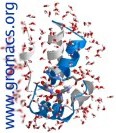 |
g_rdfMain Table of Contents |
VERSION 3.1
Thu 28 Feb 2002
| VERSION 3.1 |
The structure of liquids can be studied by either neutron or X-ray scattering. The most common way to describe liquid structure is by a radial distribution function. However, this is not easy to obtain from a scattering experiment.
g_rdf calculates radial distribution functions in different ways. The normal method is around a (set of) particle(s), the other method is around the center of mass of a set of particles.
If a run input file is supplied (-s), exclusions defined in that file are taken into account when calculating the rdf. The option -cut is meant as an alternative way to avoid intramolecular peaks in the rdf plot. It is however better to supply a run input file with a higher number of exclusions. For eg. benzene a topology with nrexcl set to 5 would eliminate all intramolecular contributions to the rdf. Note that all atoms in the selected groups are used, also the ones that don't have Lennard-Jones interactions.
Option -cn produces the cumulative number rdf.
To bridge the gap between theory and experiment structure factors can be computed (option -sq). The algorithm uses FFT, the gridspacing of which is determined by option -grid.
| option | filename | type | description |
|---|---|---|---|
| -f | traj.xtc | Input | Generic trajectory: xtc trr trj gro g96 pdb |
| -s | topol.tpr | Input, Opt. | Structure+mass(db): tpr tpb tpa gro g96 pdb |
| -n | index.ndx | Input, Opt. | Index file |
| -o | rdf.xvg | Output, Opt. | xvgr/xmgr file |
| -sq | sq.xvg | Output, Opt. | xvgr/xmgr file |
| -cn | rdf_cn.xvg | Output, Opt. | xvgr/xmgr file |
| -hq | hq.xvg | Output, Opt. | xvgr/xmgr file |
| -image | sq.xpm | Output, Opt. | X PixMap compatible matrix file |
| option | type | default | description |
|---|---|---|---|
| -[no]h | bool | no | Print help info and quit |
| -[no]X | bool | no | Use dialog box GUI to edit command line options |
| -nice | int | 19 | Set the nicelevel |
| -b | time | -1 | First frame (ps) to read from trajectory |
| -e | time | -1 | Last frame (ps) to read from trajectory |
| -dt | time | -1 | Only use frame when t MOD dt = first time (ps) |
| -[no]w | bool | no | View output xvg, xpm, eps and pdb files |
| -bin | real | 0.001 | Binwidth (nm) |
| -[no]com | bool | no | RDF with respect to the center of mass of first group |
| -cut | real | 0 | Shortest distance (nm) to be considered |
| -fade | real | 0 | From this distance onwards the RDF is tranformed by g'(r) = 1 + [g(r)-1] exp(-(r/fade-1)^2 to make it go to 1 smoothly. If fade is 0.0 nothing is done. |
| -grid | real | 0.05 | Grid spacing (in nm) for FFTs when computing structure factors |
| -nlevel | int | 20 | Number of different colors in the diffraction image |
| -wave | real | 0.1 | Wavelength for X-rays/Neutrons for scattering. 0.1 nm corresponds to roughly 12 keV |